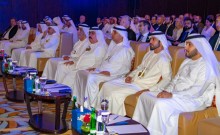 The UAE has made significant achievements with recent airspace restructuring, according to speakers at Global Air Traffic Management (GATM). At the event, delegates had deleberations about achievements, challenges and opportunities the industry is facing. During his welcome address, Ibrahim Ahli, Deputy CEO, Dubai Air Navigation Services (dans), said, “The objective for the UAE is to align its strategic plan with the global plan and methodology.” Mentioning further that Dubai International Airport is busy 24*7, he stated how many European airports are unable to achieve this due to curfews. He informed that while it presents opportunities, we must remain mindful of challenges too. He said, “Even minor routine maintenance can present challenges when you are open 24*7.”
The UAE has made significant achievements with recent airspace restructuring, according to speakers at Global Air Traffic Management (GATM). At the event, delegates had deleberations about achievements, challenges and opportunities the industry is facing. During his welcome address, Ibrahim Ahli, Deputy CEO, Dubai Air Navigation Services (dans), said, “The objective for the UAE is to align its strategic plan with the global plan and methodology.” Mentioning further that Dubai International Airport is busy 24*7, he stated how many European airports are unable to achieve this due to curfews. He informed that while it presents opportunities, we must remain mindful of challenges too. He said, “Even minor routine maintenance can present challenges when you are open 24*7.”
Giving the keynote address, Mohammed Al Dossari, Director, Air Navigation and Aerodromes Department, General Civil Aviation Authority (GCAA) discussed the need for the region to embrace the Global Air Navigation plan while expanding upon the improvement opportunities it offers for operations and how it can align with the UAE’s 2020 goals. “The UAE successfully completed phase three of the airspace restructuring project in an extremely tight time frame,” he mentioned. “This has increased the UAE airspace access and we are on track to meet our predictions for forecast capacity for 2020.”
Delegates at GATM heard a real world example of how digitisation can revolutionise air traffic management, with Brett Weihart, CEO, Scandinavian Mountains Airport presenting a case study of the airport’s implementation of the first international airport in the world to be built without a traditional tower. “A traditional tower has a higher investment cost” said Weihart, “and the remote location creates its own difficulties of staff recruitment and retention.” He continued, “The benefits of the digital tower include a shorter build time, lower investment cost and more flexibility of opening hours, among others. Another benefit is seamless decision making.
“Intelligent algorithms will provide operators with automated alerts, predictions, and suggestions – all at their fingertips,” he stated. Also speaking at GATM, Michael Hayes, Manager, Air Navigation Regulations, GCAA, discussed the development of ATM over the years and looked in detail at the challenges presented by the growing popularity of drones. “The Unmanned Aviation Revolution has arrived,” he stated. “Our challenge is for the whole aviation community to work closely.”
“The potential of this UTM development and implementation may provide opportunities to not only allow the safe integration of unmanned aircraft into our current ATM system, but should also enable major enhancements to it, which will make management of manned operations more efficient, safe and secure.”
Other industry leaders speaking at GATM included Ryyan Tarabzoni, President, Saudi Air Navigation Services (SANS); Sharon Cooke, CEO, Airways International; Khaled AbdulRahman Al Awadhi, Director Automated Collection Systems, Roads & Transport Authority (RTA); Attila Simon, Director, Business Development of HungaroControl and Todd Donovan, Vice President, Digital Aviation, Thales Air Traffic Management. HE Mohammed A Ahli, Director General, Dubai Civil Aviation Authority (DCAA) and Chief Executive Officer, Dubai Air Navigation Services (dans) said, “Aviation is one of the pillars of growth for the UAE. All the institutions and stakeholders need to work together to achieve this growth. GATM is an ideal event for the region, as it brings together all the key players in the industry and allows them to share knowledge and learn from each other, to see the industry continue to lead the way globally.”
Breaking News
- Dusit International expands Saudi portfolio with new dusitD2 resort in Al Ahsa
- Emirates prohibits use of any kind of power bank onboard Emirates flights from 1st October 2025
- Red Sea Global unveils ‘Red Sea Health’ with first facility opening at new airport
- Department of Culture and Tourism – Abu Dhabi extends partnership to host multiple UAE Warriors events in Al Ain Region
- PIF and Golf Saudi launch PIF Future Fairways, showcasing the future of golf in Saudi Arabia
- Riyadh Air signs global distribution agreement with Amadeus in preparation for take-off
- Diriyah and THC explore new urban air mobility ventures
- VFS Global renews contract for Germany visa services across the Middle East; adds four new locations to the network
- Mileo The Palm, Hotel and Residences to open by this September
- RateHawk study reveals 92% of travel professionals are purpose driven
- Oman Air Holidays launches new digital platform with TUI
 Tourism Breaking News
Tourism Breaking News


